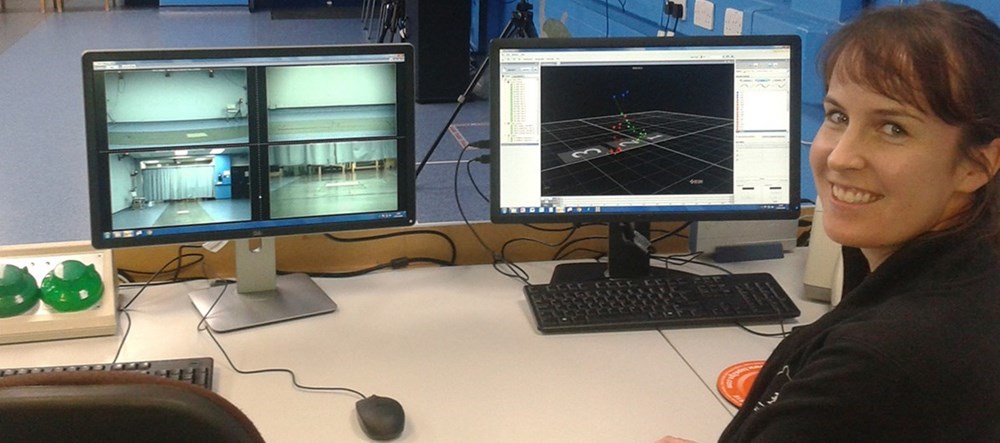Walk this way
Walking, running and moving are things that most people can luckily take for granted much of the time. But, if you have an injury or disability this can make these activities more difficult. This is where rehabilitation engineering comes in. Everybody is different - and engineers like Louise help design equipment that will work for a particular person.

Walking, running and moving are things that most people can luckily take for granted much of the time. But, if you have an injury or disability this can make these activities more difficult. This is where rehabilitation engineering comes in. Everybody is different and engineers like Louise help design equipment that will work for a particular person.
So if you like maths, science and solving problems, and want to use the latest technology to make a big personal improvement in someone’s life, read on to find out more about a career in biomedical engineering!
Name: Louise Way
Job: NHS Clinical Scientist Training Programme (STP), currently working in Rehabilitation Engineering
A-levels: maths, biology, chemistry, psychology
Undergraduate degree: BEng, Biomaterial and Tissue Engineering, University of Sheffield
Postgraduate degree: PhD, Bioengineering and the Biomechanics of Tendons, University of Sheffield
Where do you work?
I am currently training to be a Clinical Scientist working in Rehabilitation Engineering. I’m in my 3rd and final year of the NHS Scientist Training Programme (STP). As a trainee my work varies massively between any of the hospital’s rehabilitation services; the Clinical Gait Analysis Laboratory (gait means how people move – Ed), the Specialist Disability Service, the Wheelchair Service and the Rehabilitation Engineering workshop.
What do you do?
In the Gait Laboratory, as an engineer, I’m involved with the working of the equipment in the lab. This includes 16 infra-red cameras, 4 video cameras, 3 force plates, a pressure sensitive plate and electromyography electrodes (electromyography records the electrical activity of skeletal muscles - Ed).
The engineer is responsible for collecting the data as the patient walks up and down the lab wearing retro-reflective markers on the anatomical landmarks of their body (such as specific locations on their pelvis and legs) which is tracked by the infra-red cameras. The engineer then processes this kinematic, kinetic (two subjects that deal with movement – Ed), video and pressure data into a report ready to be interpreted by the physiotherapist, orthopaedic surgeons and orthotists (professionals who provide splints, braces and special medical footwear - Ed ) in the multi-disciplinary team.
In the Specialist Disability Service we are involved in the design, manufacture and issue of bespoke equipment for patients with complex needs when their needs are not able to be met with pre-existing equipment. In postural management this can range from custom-shaped wheelchair seating, complex armchair positioning and bed positioning aids. We are also involved in modifying wheelchair controls, environmental controls and computer access. In the Wheelchair Service engineering solutions are used to meet patient’s mobility needs.
How does your work affect people’s lives?
Rehabilitation Engineering affects lives on a daily basis, including the patients we interact with every day, and their family and carers. We aim to make daily activities easier for people with complex needs using engineering principles and solutions.
What inspired you to be an engineer?
I’ve always enjoyed problem solving and have always been a logical thinker. I liked to know how things worked and interacted with their environment.
There are a number of different routes you can take into a career in engineering. What route did you take and why?
I did maths, biology, chemistry and psychology A-levels. I knew I either wanted to study medicine or engineering, so I combined both to study a BEng in Biomaterial and Tissue Engineering at university. After graduating I went on to do a PhD in bioengineering and biomechanics of tendons. This was great but I craved a more direct application of my work and wanted to see immediate results so the clinical environment suits me perfectly.
How important was studying maths and science in school for what you do now?
Very! I wish I’d studied physics to a higher level than GCSE at school as this would make my job a lot easier now!
There are fewer women working in engineering than men. What would you say to girls who might be interested in a career in engineering?
Go for it! Prove them wrong! In engineering situations women apparently use the creative part of their brain more and I reckon this can lead to innovation and thinking “outside the box”.
What do you like most about engineering?
Coming up with an idea or making a piece of equipment and then to see it working in real life and changing the way someone lives their life.
What do you like to do in your spare time?
I like to get outdoors when I can and when the British weather allows! I like to cycle to and from work as it is brilliant exercise and a great way to set me up for the challenges of the day ahead. I also ride horses and compete in horse trials.
What personal qualities are important for being an engineer?
An “anything is possible” attitude, a hands-on approach and a good sense of humour are all important for when things don’t work how you would have hoped!
Why should young people think about going into engineering?
You get to see your ideas come to life and you can really have an impact on people’s lives, regardless of the type of engineering you go into.
If you could go back in time and invent anything, what would it be?
The lightbulb, because then I could say “let there be light”!
More links:
Engineering at Sheffield University
NHS Scientist Training Programme